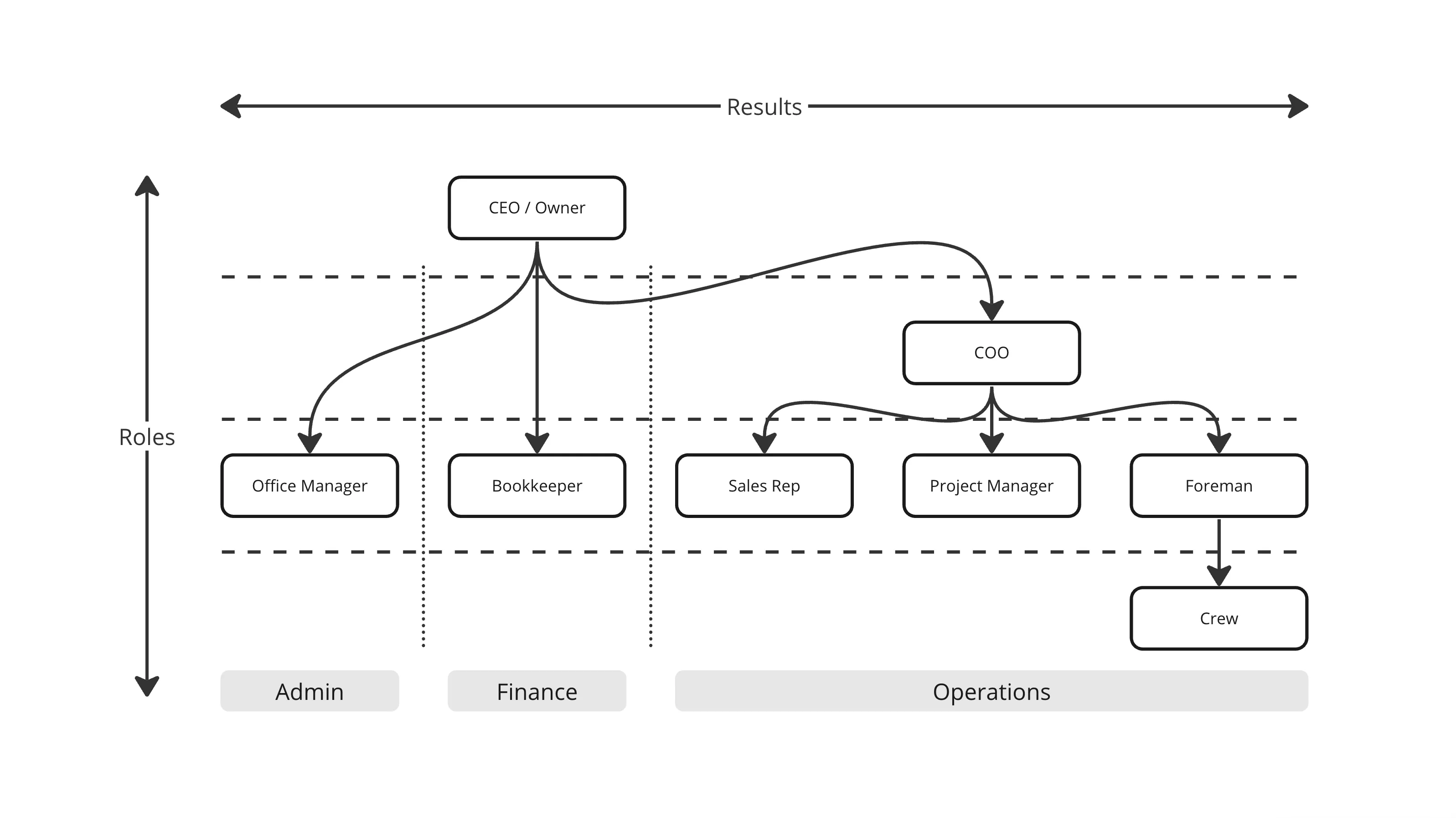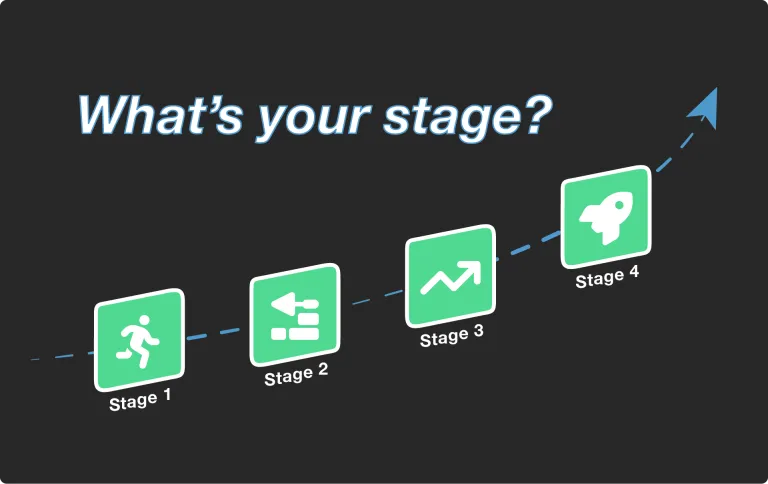
If your team is already bigger than 5 people or if you aspire to get there, then you’re going to need a clear plan for who is responsible for what.
Enter the org chart. Now, hold on. I can already hear some of you - “My business doesn’t need an org chart! That stuff is for huge corporate companies”.
Yes, you really do need one, but it’s probably not what you’re thinking. Here’s why.
Why you need an org chart
An org chart is simply a map for defining how decisions get made in your business.
If your team is less than five people, you may not need the chart yet, but you do need the building blocks. And if you don’t embrace this tool, then one of three things will happen:
- you will end up having to make all the decisions; OR
- the wrong people will make decisions (and it’s not their fault because you didn’t make things clear); OR
- no one will make decisions because no one is sure who can (and this is your fault, too)
None of these options is healthy for your business and all of them will stunt your company’s growth. Many of you are burned out today because you’re in option 1 mode - you make all of the decisions. That makes you the ceiling on your business. Building an org chart will bring clarity for your entire team about how and where decisions are made.
So, what does an org chart look like?
The structure of an org chart
The map you build needs to be clear, simple, and must help everyone understand exactly where and how decisions are made.
The chart will be comprised of two basic components: results and roles. Results define the sorts of things and decisions your business must make to provide for your customers and grow a healthy business. Roles define the positions that are responsible for delivering those results.

Now, let’s expand on roles and results with 4 steps to build your org chart.
1 - Define your mission
Slow down there! Before you start building your chart, it’s crucial that you are clear on exactly what you’re trying to accomplish and where you’re trying to take your business.
I’ve written about this in more detail here, so I won’t go deep today, but you need to be clear about what you’re trying to accomplish, by when, and why it matters. This is the very foundation of building your org chart because it will inform the results you’re aiming to achieve with the team structure of your business. If you don’t have a clear mission, go do that first. Right now. I’ll wait.
Got your mission locked in? Good. Now let’s move on to the next step of building your org chart.
2 - Define the major results your business needs to deliver
What are the big things your business will need to do in order to execute on your mission?
Here are a couple of generic pieces that most companies are going to need, but you might want to go further than this: administrative, financial, and operational. In most cases, administrative and financial functions are the underpinnings of keeping a business healthy and functional while your operational results are about how you actually deliver value to your customers. Operations can often be broken down into additional results areas like sales, marketing, product, and support.
Once you’ve identified the major results areas your business needs to make decisions in, we can move on to the roles you need to deliver those results.
3 - Define the roles
This step will be very dependent on the size of your team - bigger teams will need more layers of management and support, while smaller teams will require people to “wear more hats”.
In this step, your job is to get specific about the results each part of your organization is responsible for delivering. Does your product or service have design or engineering considerations? Do you need a full-time sales team member? Is your job volume high enough, or are the projects complicated enough that you need a project manager? Do you have enough crews or teams that you need a leader to oversee those teams? When you’re clear on the results each area of your business must deliver, you can move on.
Next, you need to break the roles down into actual positions with assigned responsibilities. Extreme clarity in this step is essential. I recommend using a simple document called Key Results Areas (KRA) to communicate exactly what decisions and results each position is responsible for.
A word of caution on this step: do not build KRAs with a particular individual in mind! People come and go on teams, but the positions do not. So make sure that the KRA you create is designed for what your business needs, and not for what one of your team members is doing today.
This step will probably take the longest, but don’t skip it. Once you have positions and KRAs defined to produce the results you need to deliver, then it’s time to start looking at the team you have.
4 - Fill roles with people
After years and years of working in the trenches on this step, I’ve come to believe that this step is as much art as it is science.
Before you make any changes to your team structure, you must communicate clearly and repetitively across your entire team. You need to spell out why you’re making changes, when you’re making changes, and explain the benefits for your customers, your company, and your team. And you cannot communicate this one time and think you’re done. You have to keep explaining the changes to your team. Over, and over, and over again. Before you start making changes, not once you’ve already started.
Now that your team has had the benefit of time to prepare for changes, you can begin to identify which of your current team members are best suited for the different positions you’ve identified. Again, this is as much art as science, but you’ll want to make sure that your team members participate with you in these decisions and have the opportunity to be involved in a conversation about role changes. And again, using KRAs will be an enormous help in clearly communicating with your team.
This process will take some time - don’t rush it. And most importantly - communication, communication, communication.
Watch out for these gotchas
A couple of words of caution as you embark on this journey - spare yourself some pain and learn from me, because I’ve made all of these mistakes myself.
Don’t think about individuals on your team when building your org chart. Don’t misunderstand me - the individuals on your team do matter and I want you to be the sort of employer who cares and goes to great lengths to serve your team. But the whole point of this step is to determine what your business needs so that it can grow in a way that is good for your customers, your profits, and your team. Remember, people will come and go on your team, but the results you need to deliver and the roles you need to deliver them will not.
Focus on results. Each member of your team needs to know exactly what they’re responsible for and why it matters. If I’m repeating myself here, it’s because this is so important.
Communication is key. Plan to overcommunicate with your team. When you’re annoyed with yourself for communicating the changes you’re planning to make and why the changes matter, then you’re just getting started. Don’t make the mistake of springing change on your team command-and-control style! Change is hard for people. Enroll your team in the process and make time to explain what you’re doing and why.
Don’t try to make everyone happy. Let’s just be real - you’re not going to be able to make everyone happy. Yes, you need to take care of your people and love them well. But don’t forget that your team members are here to serve your customers and the interests of your business. Do your best to balance your team members’ needs with the needs of the business, but also recognize that you probably will not be able to satisfy everyone in the process. And that’s okay - it’s not your job to make sure that every single person on your team is happy. Your job is to steward your business well and ensure that it remains healthy to continue serving your customers and providing for your team.
Don’t rush this. Settle in for a longer ride. Smaller teams can often make changes more quickly, but even with a small team you want to be very intentional about changing your team structure. Expect to take at least a full quarter with this, and in many cases two quarters.
Don’t overcomplicate it. Trust me: you’re not going to get this perfect on your first rollout. So just embrace the idea that this is going to be an ongoing process. Get it to good enough, communicate well with your team, and move forward. And give yourself a lot of grace.
How this will make you money
When you have the right structure in place, then your business will operate more efficiently, be able to sustain growth, better serve your customers, and improve profitability.
If your team is bigger than 5 people, then you’re right on the edge of needing a clear structure for decisions and responsibilities. And if your annual topline revenues are in the $2 million or more range, then you almost certainly are in a place where you need to be putting some more structure around your business and your team.
Action steps
If you need to build an org chart for your business, then here are the next steps you need to take.
- Carve out time to focus on getting started. I recommend setting aside at least 4 undistracted hours.
- Identify the major results areas of your business. Admin? Operations? Finance? Sales? Design?
- Begin to build a structure of responsibility for results that makes sense for your team size and where you want to go in the next stage of your business.
- Build a KRA for every position.
- Outline a rollout plan that includes deep and regular communication with your team.
To thriving,
Zach
PS: I know this can feel like an overwhelming task. If you need some direction or some help putting together a plan, let’s chat!


